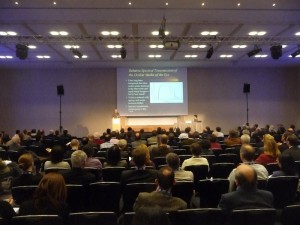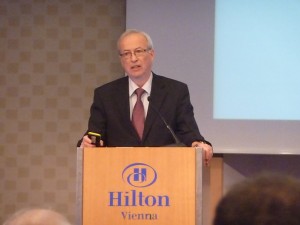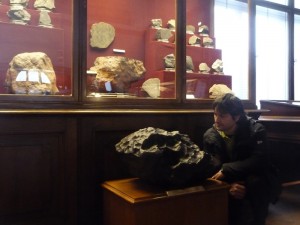The curtain falls on CIE 2010

Way too late…
March 17, 2010
Light pollution in Physics Today
March 24, 2010I finally find some time to report about the last day of the CIE conference in Vienna. Where was I? Ah, yes, the Gala dinner. It was very nice, accompanied by Strauss and Mozart music, plaid by three young musicians (piano, violin and cello). At some point a number of dancers appeared. The men with a black suit and the ladies wearing a long white dress. It looked like his majesty, the Kaiser Franz Joseph could appear any time. Then the couples dissolved and went searching for a companion around the room. A few minutes after, lots of scientists and engineers could be seen dancing, embracing either a white lady or a black dressed man. A most funny sight, indeed.
The day after, back in business. I went to several talks reporting on the effects of lights on human cycles. Interesting studies were presented, touching upon different aspects of indoor lighting. I mention here only three examples. One was a study of the melatonin content in women working in a supermarket under artificial lighting. Another reported on the behavioral effects of a new lighting system in an hospital and a third the study focused on kids in a ground school. All of them rather interesting, clearly showing that light has indeed an effect. Most controversial is the issue of the effect of blue light. As you may know, it is only since a few years that we know about the existence of a third type (but there might be more) of light receptors within the human eye. The first two are the so-called cones and rods, responsible for the sighting in high and low illumination conditions. The third kind of receptors has nothing to do with seeing. But it has a fundamental role in regulating the production of some hormones, the most famous of which being melatonin. This is normally produced during the night (i.e. when it is dark), and has an important role in regulating the circadian rhythms. In addition, it is a very important antioxidant. Therefore, since its production is regulated by the light, it is clear that the exposure to artificial light during hours when there should be none is expected to produce negative effects on human and animal health. So, it is a serious issue. Some people tend to minimize, others take it very seriously. Certainly, we are just starting to understand it.
In the opinion of many researchers, just because we do not fully know the depth of these effects, we should be very careful. One important aspect to consider is that the biological receptors present in our eyes are sensitive to blue light (and not very much to yellow of red light). Therefore, any blue source is often regarded as potentially dangerous when used at night time, when the organism would normally secrete melatonin. Now, and this has emerged very clearly during the conference, industry is very much oriented towards replacing the current lighting systems with high efficiency LEDs, most of which emit a rather blue/white light. The claimed advantage of this source is that the amount of electric power one has to supply in order to produce the same amount of visible light (usually measured in lumen), is much better than any other known source. As a matter of fact, though, the modern high pressure sodium lamps (HPS) are not much worse than current-technology LEDs, and have the advantage they produce a yellow/orange light, not affecting melatonin production. This is why one of the requirements placed by professional and amateur astronomers is that HPS should be used whenever possible. In fact, besides what I just said, HPS produce light within a rather confined spectrum, implying that the impact on astronomical observations is limited to a small portion of the visible spectral range.
However, from what I gathered at the conference, industry is practically ready to flood the marked with these new LED lamps. At the conference some independent researchers have convincingly shown that LEDs are not yet mature for replacing HPS in street lighting. But they probably will in the next years, and they will possibly achieve much better efficiency, so that lighting will become much cheaper in terms of energy consumption.
This might seem good, especially in sight of the claimed decrease in the production of CO_2. That is certainly a plus. However, let me expose here the “theorem of my grandmother“. When I told my grandma that the new compact fluorescent lamps produce the same effect of an incandescent bulb but with a much lower energy consumption, she was delighted. “Great” – she said – “I can now put a couple of them in the garden and leave them on all night long!“. Do you see the net effect? Sure. People will put up more light, simply because is cheaper, and this will produce an energy saving much smaller than what is forecasted based on the current level of lighting.
Of course I have prohibited my grandma to do so (!). But who will do the same with millions of people, once they get a light source that produces the same amount of light at a price which is 5 or even 10 times lower? The net effect of street/outdoors LED lighting will be a terrible increase of light pollution. Also, due to the blue peak present in the spectrum of many LEDs (that is the cause for the withe/bluish color of LEDs), light pollution will finally invade the darkest part of the natural dark sky spectrum. And what is bad is that this is now coming in the form of a continuum (while mercury vapor, for instance, produces at least isolated emission lines, much easier to get rid of in professional astronomical observations). So, indeed, as the delegate from the big lighting company said the first day, the future ahead of us is bright. It seems a lost battle…
However, some positive signs came out of the CIE conference. Many participants manifested their sympathy to our “cause”. The president and vice-president of CIE explicitly told me that they are very open and receptive to our requirements, and there is certainly room for discussion. But maybe the most promising and encouraging message came from W. van Bommel, former president of CIE, who gave the conference’s closing speech. His presentation was a self-criticism, and he tried to answer the question “are we (CIE) doing it right?“. But the big surprise came at the end, when he put up the last slide of the conference. “This is a photo I took in Australia during my vacations“. It was a beautiful picture of the Milky Way, as you can see it only from a dark site, far from any artificial lighting. “If we do things right, maybe one day we will see again the Milky Way, which I guess many in this audience have never seen“. I could have not imagined a better way of ending the conference. I was so captured that I even forgot to take a picture; it seemed to me quite emblematic that a conference on lighting would end with a dark sky.
Everything comes to an end. The conference was over and I had just the time to say good bye to a few people before going for the last thing I had planned for my short stay in Vienna: a visit to the Museum of Natural History. This is a very classical building, where one breaths the atmosphere of those museums one can only find described in books or portrayed in movies. The collections are exposed in wooden displays, and bring back memories of the glorious Habsburgs days, when far reaching expeditions were bringing to the empire’s capital wonders from all over the world. Of course, for me the most attractive section was that dedicated to meteorites. The collection contains very nice slices of metallic meteorites, showing those peculiar Widmanstätten’s figures I had so far seen only in text books. Also, there were a couple of rather big specimens. I had seen a few small ones collected in the deserts of Chile. But never so big as these ones. Indeed impressive, especially if you think they come from who knows where. Those are really extraterrestrial things. If you think about it, it is one of the exceptional cases where an astronomer can put her hands on the subject of study. A privilege the vast majority of astronomers do not have. Let alone cosmologists 😉
A train brings me back to the airport. And then the flight back to Munich. I have many faces in mind, met during these last three days. New ideas in mind and lots of things to do. I deeply hope the future will be darker…





1 Comment
(…)”it seemed to me quite emblematic that a conference on lighting would end with a dark sky”(…).
Indeed! As we may listen to the silence, we also should look through the dark… skies.
Once again, thanks for your posts.